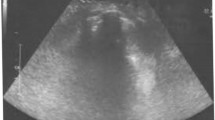Abstract
Purpose
Radiation pneumonitis (RP) is a serious complication in patients undergoing thoracic radiotherapy (TRT). Serum KL-6 and SP-D have been shown to increase in several kinds of interstitial pneumonia. To evaluate their clinical usefulness in detecting RP, we serially measured them in patients receiving TRT.
Materials and Methods
Thirty-nine patients, who received TRT for lung cancer between July 1999 and April 2004, were prospectively studied. Serum levels of KL-6 and SP-D were measured using enzyme-linked immunosorbent assays. Patients were followed up until August 2004 or their deaths.
Results
During the period, RP occurred in 19 patients. In five patients with diffust RP extended outside the radiation field, serum KL-6 levels increased, reaching more than 1000 U/mL. Serum KL-6 levels at 40 gy in patients who developed RP were higher than those without it (p=0.0363, Mann-Whitney U test). In addition, serum KL-6 levels at 40 Gy in patients who developed RP were higher than those of pretreatment (p=0.0126, Wilcoxon signed rank test). On the other hand, there were no statistical differences between SP-D at 40 Gy and those before TRT (p=0.1165).
Conclusions
Increased KL-6 at 40 Gy compared with those before treatment in patients undergoing TRT may be of clinical significance. KL-6 proved to be a useful indicator for estimating RP, while usefulness of SP-D was not confirmed in this study.
Similar content being viewed by others
References
Monson JM, et al. Clinical radiation pneumonitis and radiographic changes after thoracic radiotherapy for lung carcinoma. Cancer 1998; 82: 842–850.
Satoh H, Yamashita Y, Ohtsuka M, Sekizawa K. Radiation induced pneumonitis outside the radiation field. Mayo Clin Proc 1999; 74: 743–744.
Goto K, et al. Serum levels of KL-6 are useful biomarkers for severe radiation pneumonitis. Lung Cancer 2001; 34: 141–148.
Sasaki R, et al. Clinical significance of serum pulmonary surfactant proteins A and D for the early detection of radiation pneumonitis. Int J Radiat Oncol Biol Phys 2001; 50: 301–307.
Kohno N, et al. New serum indicator of interstitial pneumonitis activity. Sialylated carbohydrate antigen KL-6. Chest 1989; 96: 68–76.
Kobayashi J, Kitamura S. KL-6: a serum marker for interstitial pneumonia. Chest 1995; 108: 1–5.
Kuroki Y, Takahashi H, Chiba H, Akino T. Surfactant proteins A and D: disease markers. Biochem Biophys Acta 1998; 1408: 334–345.
Iwata Y, et al. Serum levels of KL-6 reflect disease activity of interstitial pneumonia associated with ANCA-related vasculitis. Intern Med 2001; 40: 1093–1097.
Fukaya Y, et al. KI-6 as a novel marker for activity of interstitial pneumonia in connective tissue disease. Rheumatol Int 2000; 19: 223–225.
Honda Y, et al. Pulmonary surfactant protein D in sera and bronchoalveolar lavage fluids. Am J Respir Crit Care Med 1995; 152: 1860–1866.
Shapiro DL, Finkelstein JN, Rubin P, Siemann DW, Rubin P. Sequential effects of irradiation on the pulmonary surfactant system. Int J Radiat Oncol Biol Phys 1982; 8: 879–882.
Rubin P, et al. Surfactant release as an early measure of radiation pneumonitis. Int J Radiat Oncol Biol Phys 1983; 9: 1669–1673.
Rubin P, Finkelstein JN, Siemann DW, Finkelstein JN, Penney DP, Predictive biochemical assays for late radiation effects. Int J Radiat Oncol Biol Phys 1986; 12: 469–476.
Rubin P, et al. Serum markers for prediction of pulmonary radiation syndromes. Part I: surfactant apoprotein. Int J Radiat Oncol Biol Phys 1989; 17: 553–558.
Rubin P, Finkelstein J, Shapiro D. Molecular biology mechanisms in the radiation induction of pulmonary injury syndromes: interrelationship between the alveolar macrophage and the septal fibroblast. Int J Radiat Oncol Biol Phys 1992; 24: 93–101.
Honda H, Kohno N, Akiyama M, Hiwada K. Monitoring of serum KL-6 antigen in a patient with radiation pneumonia. Chest 1992; 101: 858–860.
Kohno N, et al. Circulating antigen KL-6 and lactate dehydrogenase for monitoring irradiated patients with lung cancer. Chest 1992; 102: 117–122.
Homma S, Satoh H, Kagohashi K, Sekizawa K. Serum KL-6 6 and severe pneumonitis after irradiation. Australian J Cancer 2003; 2: 173.
Takahashi H, et al. Diagnostic significance of surfactant proteins A and D in sera from patients with radiation pneumonitis. Eur Respir J 2001; 17: 481–487.
Kohno N, et al. Delection of soluble tumor-associated antigens in sera and effusions using novel monoclonal antibodies, KL-3 and KL-6, against lung adenocarcinoma. Jpn J Clin Oncol 1988; 18: 203–216.
Kohno N, et al. KL-6, a mucin-like glycoprotein, in bronchoalveolar lavage fluid from patients with interstitial lung disease. Am Rev Respir Dis 1993; 148: 637–642.
Nagae H, et al. Enzyme-linked immunosorbent assay using F(ab′)2 fragment for the detection of human pulmonary surfactant protein D in sera. Clin Chim Acta 1997; 129: 127–136.
Roswit N, White DC. Severe radiation injuries of the lung. Am J Roentogenol 1977; 129: 127–136.
Gross NJ. Pulmonary effects of radiation therapy. Ann Intern Med 1977; 86: 81–92.
Takahashi T, et al. Surfactant protein D as serological indicator of Pneumocystiscarinii pneumonia in a child with acute lymphoblastic leukemia. J Med 2001; 32: 41–51.
Inoue Y, et al. Evaluation of serum KL-6 levels in patients with pulmonary tuberculosis. Tuber Lung Dis 1995; 76: 230–233.
Author information
Authors and Affiliations
Corresponding author
Rights and permissions
About this article
Cite this article
Matsuno, Y., Satoh, H., Ishikawa, H. et al. Simultaneous measurements of KL-6 and SP-D in patients undergoing thoracic radiotherapy. Med Oncol 23, 75–81 (2006). https://doi.org/10.1385/MO:23:1:75
Received:
Accepted:
Issue Date:
DOI: https://doi.org/10.1385/MO:23:1:75




